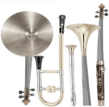This book distinguishes itself from others on orchestration in several ways. Firstly, it focuses exclusively on orchestration and minimizes discussions about individual instruments. Its primary emphasis lies in exploring how instruments collaborate within an orchestral context.
Secondly, it describes a method for orchestration analysis called segment analysis, first presented here, designed to investigate the contribution of each individual instrument to the orchestration.
Thirdly, it establishes a systematic approach towards orchestration by treating orchestration as a cluster of methods rather than, as is often done, intentions. This simplifies things since the possible intentions in orchestration is potentially endless, far exceeding the number of methods. It is, however, crucial to note that this book does not aim to provide a comprehensive presentation of orchestration methods. It proposes a framework for approaching orchestration based on key orchestration methods.
Finally, this book centers around six movements, with a combined playing time of approximately 30 minutes. All examples within this book are drawn from these six movements. This design allows readers to acquaint themselves with the examples more efficiently, eliminating the need for extensive hours spent on initial familiarization.
